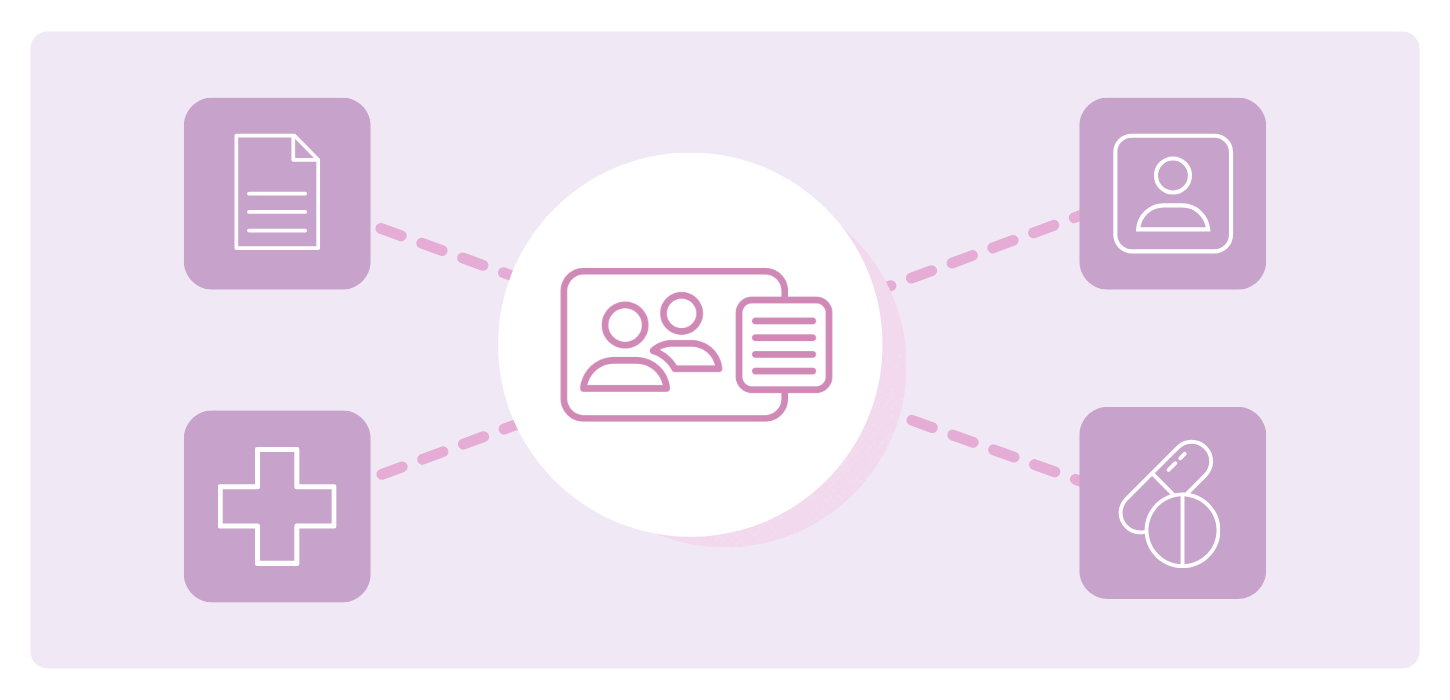At A Glance
Identity resolution unifies fragmented IDs into complete customer profiles, helping companies understand their audiences and deliver personalized, privacy-compliant experiences in a cookie-light world. With Experian’s AI-powered identity resolution solution, marketers gain the scale, accuracy, and compliance to compete while making marketing more human.In this article…
Every marketer has seen it: a customer browses reviews on a laptop, adds items to a cart on mobile, then “disappears.” In reality, they just likely switched devices or logged in with a different email. Identity resolution connects these scattered signals into a single profile so you never lose sight of the customer journey.
Identity resolution is what helps you keep track of customers who bounce around.
Connecting scattered signals into a single customer profile can help you deliver seamless experiences, meet strengthening privacy standards, turn first-party data into measurable results, and fuel better customer analytics.
See our identity resolution solution in action
What is identity resolution?
Identity resolution is the process of pulling together the different identifiers a customer uses and connecting them to a single profile. Without it, you’re left with an incomplete picture of the customer — like a cart tied to one email, an app login tied to another device, or a loyalty swipe that never links back to the same person.

Common identifiers include:
- Cookies: Short-lived browser data
- Emails: Plain-text and hashed
- Device IDs: Mobile advertising IDs (MAIDs) or app-based identifiers
- Loyalty IDs: Program numbers that tie online and offline activity
- Hashed PII: Personally identifiable information (PII) encrypted for privacy
Ultimately, identity resolution can help you recognize the same customer wherever they engage.
Why does identity resolution matter now?
Marketers face incomplete views, data silos, privacy regulations, and shrinking visibility:
- Rising consumer expectations: People want seamless, personalized journeys across touchpoints.
- Privacy-first environment: Consumer privacy legislation (like the GDPR, CCPA, GLBA, FCRA, and new state laws) makes compliance non-negotiable.
- Signal loss: The decline of cookies, MAIDs, and walled gardens are pushing brands toward first-party data.
Experian utilizes AI and machine learning to fill these gaps, predict behaviors, and connect signals across devices — providing marketers with a clear, privacy-safe view of their customers, even when traditional identifiers are missing.
In this environment, identity resolution matters because it gives marketers a way to deliver seamless, personalized customer experiences and engage audiences effectively while respecting their privacy. It’s the basis for turning consented first-party data into measurable marketing outcomes without sacrificing trust.
Why is identity resolution critical in a privacy-first world?
Even as cookies linger, marketers have already shifted their strategies to rely on first-party data, where choice and transparency are the baseline expectation. At Experian, our long history as a regulated data steward makes us a uniquely capable and trusted partner for managing modern compliance expectations. Our identity resolution solutions maximize the value of permission-based data while meeting consumer demand for privacy, personalization, and control.
Struggling with scattered customer data? Experian makes identity resolution seamless
How does identity resolution help brands?
Identity resolution turns fragmented signals into unified profiles that drive personalization, efficiency, and compliance. Here’s how it creates measurable business impact.
Creates a unified customer view
One of the biggest advantages of identity resolution is the ability to integrate data from loyalty programs, point-of-sale (POS) systems, customer relationship management (CRM) platforms, web analytics, and offline sources into a single, comprehensive profile. Experian strengthens identity resolution with AI-driven clustering models that resolve household and individual identities across billions of signals with greater accuracy.

With a clearer picture of each customer, brands see higher match rates and larger addressable audiences, which translates to more substantial reach and better return on ad spend (ROAS).
Enables better personalization
Customers constantly switch devices, update their information, and change preferences. Experian makes it easier to keep pace with these changes through frequent data enrichment and near-real-time identity resolution via Activity Feed.
Combined with our long-standing use of AI and machine learning, this approach ensures shifting behaviors are captured quickly, enabling timely personalization, and more responsive engagement.

With less delay from data to action, the result is faster response times and higher conversion rates.
Improves the customer experience
Customers notice when brands deliver relevant ads and contextual content across every channel. Consistency matters! But consistency doesn’t just happen on its own; it comes from identity resolution, which keeps the customer journey connected.

As brands maintain continuity, they build trust, strengthen engagement, and increase customer lifetime value.
Drives better marketing ROI
Not every profile is valuable. Identity resolution helps marketers identify the highest-value audiences and reduce wasted spend.

That efficiency leads to lower CPA and a higher overall ROI across campaigns.
The power of modeling from a stronger foundation
When you have a unified customer view, your models are built on better data. That means you can find more people who look like your best customers, build more responsive audience segments, and target with greater accuracy. This foundation can lead to better spending, more relevant campaigns, and a higher ROI.
Maintains privacy compliance
With GLBA/FCRA-grade standards and consumer choice mechanisms like opt-outs and data correction, you can protect your brand while maintaining personalization — without compromising legal or ethical safeguards.

What are some identity resolution use cases and examples?
Every industry faces its own unique identity challenges, but identity resolution is the common thread that turns scattered data into connected experiences. Let’s break down how companies in different verticals are putting it to work (and the kinds of results they’re seeing).
Retail and e-commerce
Shoppers bounce between websites, carts, and checkout lines, leaving behind scattered signals in the process. In retail, identity resolution bridges the gap between online and in-store experiences by matching online carts with loyalty swipes or connecting connected TV (CTV) exposure to in-store sales. This means fewer silos, better targeting, and more personalized offers wherever people shop.

Our 2025 Digital trends and predictions report calls out that omnichannel experiences aren’t optional anymore. With CTV and social dominating spend, brands need identity resolution to cut through silos and build a complete view of customer behavior.
Financial services
In financial services, identity resolution makes it possible to deliver personalized, compliant offers like refinancing options for likely mortgage switchers or the right rewards card for frequent spenders.
Our partnership with FMCG Direct to create Consumer Financial Insights® and Financial Personalities® segments helps banks, insurers, and lenders understand behaviors — such as credit card use, deposit balances, and investment habits — without exposing sensitive details.
Read more below about how our financial audiences enable privacy-safe personalization.
Travel and hospitality
Travel decisions aren’t always planned out in advance. Many bookings happen spur-of-the-moment, which is why real-time identity resolution is so powerful; it keeps the journey seamless when travelers jump from phone to laptop to tablet and presents relevant offers right as decisions are being made.
Windstar Cruises put this information into action with Experian’s identity graph to connect digital interactions with actual bookings, which drove 6,500+ reservations and $20 million in revenue.
Media and TV
Viewers tend to hop around between linear TV, streaming apps, and social feeds. And without identity resolution, every screen looks like a different person. Marketers can accurately plan, activate, and measure campaigns by unifying viewing behaviors into one ID with Experian’s AI-powered identity graph.

Optimum Media tackled its multiscreen challenge by partnering with Experian for identity solutions. Layering our audience insights and our AI-driven Digital Graph onto their subscriber data, they were able to connect the dots across channels, reach the right households, and measure results instead of just impressions. In the end, they finally got a clear view of what works across every screen.
Curious how identity resolution can power your customer analytics? We can walk you through it.
Healthcare and pharma
Healthcare marketers can’t afford slip-ups with HIPAA regulations. Identity resolution makes it possible to engage the right patients and providers with de-identified audiences rather than third-party cookies.

At Experian, AI and machine learning have always been part of how we power identity resolution. In healthcare, that means using AI-enhanced modeling to connect de-identified clinical and claims data with lifestyle insights. The result is a more comprehensive picture of the patient journey that helps close care gaps, reduce wasted spending, and improve outcomes.
By working with partners like Komodo, PurpleLab, and Health Union, we make it possible to activate campaigns at scale that boost engagement and adherence while keeping patient privacy front and center:
- Komodo Health enriches our identity graph with insights from millions of de-identified patient journeys plus lifestyle data, giving brands a fuller view of where care gaps exist and how to close them.
- PurpleLab connects real-world clinical and claims data to Experian’s platform, letting advertisers activate HIPAA-compliant audiences across CTV, mobile, and social with the ability to measure real outcomes like prescription lift and provider engagement.
- Health Union contributes a data set built from 50 million+ patient IDs and 44 billion+ patient-reported data points. Combined with our identity and modeling capabilities, this expands match rates and unlocks up to 76% net-new reach, so campaigns reach patients and caregivers in critical health moments.
As a result, healthcare brands can launch campaigns that are privacy-first, highly targeted, and proven to drive meaningful impact.
Audio
People use audio while commuting, working out, and even folding laundry. It can be one of the hardest channels to track because of how frequently listeners switch between apps, stations, and devices.

Experian’s identity resolution partnerships with Audacy and DAX change the game:
- Audacy helps tie scattered listening into a single view, so advertisers can follow audiences across devices and keep ads relevant in the moment.
- DAX pairs Experian’s 2,400+ syndicated audiences with its audio network, enabling brands to target precisely and launch impactful campaigns at scale.
These partnerships turn audio into an accurate channel where ads feel personal, privacy-safe, and measurable.
Gaming
Gamers don’t stick to one platform. Player data gets scattered across mobile, console, and PC, so it’s tough to keep track of individuals. Experian helps stitch those signals together so publishers can finally see the whole picture, personalize gameplay, and keep players coming back.
With enriched profiles, publishers can deliver offers that resonate and unlock fresh revenue by packaging high-value gaming audiences for advertisers outside the industry.
Unity, a leading gaming platform, is tapping into Experian’s syndicated audiences to gain player insights and help advertisers reach gamers across mobile, web, and CTV. For global publishers, unifying player data with Experian has driven higher engagement and stronger ad ROI.
How should I evaluate identity resolution providers?
When choosing an identity resolution partner, look for:
- Data scale and quality: The value of identity resolution depends on how complete and accurate the underlying data is. The right provider should bring together a wide range of identifiers from online and offline sources, maintaining high accuracy so your customer profiles are broad and reliable.
- Match accuracy and recency: The best partners also refresh their data regularly and can blend deterministic (exact, one-to-one matches) with probabilistic (pattern-based matches) methods. That way, you get the accuracy of “this email is definitely that customer” with the reach of “this device likely belongs to the same person.”
- Privacy and compliance readiness: Compliance can’t be an afterthought. Your identity partner should be ready for GLBA, FCRA, GDPR, CCPA, and the latest state-level rules with built-in tools for opt-outs, corrections, and deletions.
- Integration flexibility: A good provider fits into your world, not the other way around. Look for pre-built integrations with your customer data platform (CDP), demand-side platform (DSP), or marketing tech (MarTech) stack so you can get up and running without the heavy IT lift.
- Data analytics capabilities: You need proof that identity resolution drives ROI. Look for closed-loop measurement that ties unified IDs directly to campaign performance, so you can see what’s working and optimize with confidence.
How Experian enables enterprise-grade identity resolution
Experian delivers identity resolution at the scale, accuracy, and compliance required by the world’s largest enterprises. Our solutions are:
- Built on trust: Backed by 40+ years as a regulated data steward and rated #1 in data accuracy by Truthset, so you can act with confidence.
- Powered by our proprietary AI-enhanced identity graph: Combining breadth, accuracy, and recency across four billion identifiers, continuously refined by machine learning for maximum accuracy.
- Seamlessly connected: Pre-built data integration with leading CDPs, DSPs, and MarTech platforms for faster time to value.
- Always up to date: Frequent enrichment and near-real-time identity resolution through Activity Feed for timely personalization and more responsive customer engagement.
- Privacy-first by design: Compliance with GLBA, FCRA, and emerging state regulations baked in at every step, supported by rigorous partner vetting.
The bottom line
Identity resolution turns fragmented signals into connected, measurable, and compliant experiences. From retail to gaming, brands using it see stronger personalization, engagement, and ROI.
With Experian, you get the data, trust, and responsible AI innovation to make identity resolution work across every channel. Our approach uses AI to connect identities, predict behaviors, and deliver personalization that balances privacy with performance. If you’re ready to turn fragmented data into growth, now’s the time to start.
The world’s leading brands trust us to power identity resolution at scale. See how we can do the same for you.
Identity resolution FAQs
Deterministic uses exact identifiers (like an email) for accuracy, while probabilistic uses signals and algorithms to expand reach. Best-in-class providers usually combine both.
Identity resolution helps with personalization by unifying scattered signals into one profile. It reduces wasted spend and increases match rates, which means bigger addressable audiences and higher ROAS.
Yes. With first-party data and hashed PII, brands can still maintain addressability and personalization.
Retail, finance, travel, media, gaming, and audio all use identity resolution to personalize, attribute sales, and improve efficiency.
A customer data platform unifies the data you already own. Meanwhile, we add depth, scale, and higher match rates by layering in our identity graph and data enrichment.
Yes. Experian is GLBA/FCRA compliant, GDPR/CCPA ready, and supports consumer opt-outs and corrections to ensure responsible personalization.
Latest posts

Experian is excited to introduce our new Geo-Indexed audiences. Our Geo-Indexed audiences use a new advanced indexing classification technology to identify and reach consumers based on their geo-regional attributes. These audiences can help you discover, segment, and craft messaging for consumers without the use of sensitive personal information, so you can confidently reach your target audience without sacrificing data privacy. In this blog post, we’ll review how our new Geo-Indexed audiences can help you reach your audience while balancing data privacy and accuracy. How we collect and use data is changing The AdTech industry is undergoing a transformation as various forces shape its trajectory. One significant factor is legislation, with as many as 26 states currently considering data privacy laws. Consumer preferences also play a crucial role, as more individuals look to brands for responsible and ethical data handling practices. According to Forbes, 82% of people view brands positively when they consciously opt to refrain from using personal data for personalized ads. Major players in the field such as Apple and Google are actively pushing for a shift away from traditional methods like cookies and other identifiers in data collection and usage. These developments mark a considerable shift in how we use data. Many brands are seeking a few solutions to continue to find and reach their target audience online, but at Experian, we see a great opportunity for innovation and impact within geo-based targeting solutions. “We predict that over the next year, you will begin to see innovations in geo-based targeting methodologies that satisfy the industry's need for audience targeting with responsible data strategies. By embracing innovations in geo-based targeting and adhering to responsible data strategies, you can not only comply with these laws but continue to reach your intended audiences effectively.”jeremy meade, vp, marketing data & operations Introducing Experian’s Geo-Indexed audiences Geo-Indexed audiences from Experian allow brands to reach consumers and households based on geographic regions that over-index for a common set of attributes. Our Geo-Indexed audiences give brands the ability to: Stay connected: Maintain a touchpoint with consumers as other audience targeting solutions disappear or reduce scale due to new legislation. Expand your audience reach: With our sophisticated geo-indexing methodology, you will be reaching your target audience’s circle of influence within the geo-region. Execute where you want: By linking our Geo-Indexed audiences to Experian’s persistent identifiers, you can activate these audiences on the shelf of your platform of choice. As a part of the release of Geo-Indexed audiences, we will be rolling out three main categories: Language Ethnic Group Demographics which include: Education Household Income Marital Status Occupation Presence of Children Over the next year, we will continue to release new audiences within Geo-Indexed audiences. How you can use Geo-Indexed audiences An Auto brand has a new corporate policy restricting the use of sensitive personal information in audience targeting but would like to reach high-income earners. To reach their target audience they use the Geo-Indexed audiences to reach households who are in geographic regions that index highly for income ranges ‘$175,000 – $199,999’ and ‘$200,000+.’ Prioritize privacy without sacrificing accuracy with Experian’s Geo-Indexed audiences Our Geo-Indexed audiences are available in most major data and demand-side platforms. Visit our partner page for more information. Don’t see our audiences on your platform of choice? We can help you build and activate an Experian audience on the platform of your choice. Connect with our audience team Latest posts

In this article…What is a walled garden?Integrated marketing is more important than everPerspectives on walled gardens from Cannes Lions 2023Walled gardens aren’t going away in the near futureThe fuure of walled gardens Digital marketers face an ongoing challenge in the form of "walled gardens," closed online ecosystems where it is difficult to access user data. As we get ready for 2024, it's more important than ever for marketers to evaluate the current challenges and opportunities surrounding walled gardens and to take stock of the impact of walled gardens in marketing as an industry. What is a walled garden? A walled garden is a closed online ecosystem controlled entirely by one tech company. Advertising on these ecosystems is fairly locked down, as major tech companies with walled gardens tend to tightly control access to the user data, content, and advertising that appears within the ecosystems. Some examples of walled garden ecosystems include Google, Facebook, Amazon, and Apple. These walled gardens have particular advantages, like access to massive user bases and precise targeting within the individual ecosystems. It can also be difficult to reach said audiences outside of the ecosystems, reducing the amount of control you have over your advertising strategies. Learn more about walled gardens. Learn the differences between walled gardens and hedged gardens. Integrated marketing is more important than ever Today, it's become more crucial to connect with consumers over multiple touchpoints, which can be done from tech like connected TV (CTV) to websites, mobile devices, and even shopping in a physical store. However, as integrated marketing gains utility, many platforms with walled garden ecosystems have increased, making a truly integrated and personalized marketing strategy more difficult in many situations. As a result, many marketers have realized the value of a more streamlined marketing approach, emphasizing the importance of fully integrated advertising strategies. Though there are surely marketing advantages to gain from walled garden ecosystems, especially in audience size, the challenges they pose will require you to innovate and find more creative ways to engage with your audience from platform to platform. Perspectives on walled gardens from Cannes Lions 2023 Offering a poignant view of industry trends and ideas, the Cannes Lions International Festival of Creativity of 2023 had much to say about the significance of walled gardens in the marketing world. Let's look at two key takeaways from this year's festival. Retail media In recent years, many retail companies have started selling ad space within their own walled garden shopping platforms, dubbed "retail media." Platforms like Amazon and Walmart have developed their own particular advertising ecosystems where they sell ads to marketers within the shopping environment itself. Navigating the sell-side of retail media’s walled gardens While retail media offers marketers unique opportunities, it's not without its challenges. For one, ad space in these environments is limited, so the competition can be difficult on the sell-side, leading to higher ad costs. Additionally, this shift in dynamic also forces marketers to change how they prioritize their marketing channels, looking closer at the results of their efforts rather than focusing on particular channels within the platforms themselves. Opportunities in the buy-side of retail media’s walled gardens Brands on the buy-side see various benefits from advertising within retail media channels and walled gardens. By browsing in an online shopping environment, the users in these ecosystems are likely high-intent shoppers, people who are further down the sales funnel and who are ready to make a purchase soon. Shoppers can also be precisely targeted within these environments, as marketers are given the ability to access very specific audience segments based on details like shopping behavior, preferences, and even purchase history. Omnichannel marketing To more effectively engage audiences even among an abundance of walled garden ecosystems, speakers at the 2023 Cannes Lions Festival discussed the importance of omnichannel marketing. By emphasizing strategies that reach the consumer through multiple touchpoints, marketers can deliver a unified brand experience across channels. This allows marketers to focus more on results than specific advertising channels, including walled garden platforms. Walled gardens aren’t going away in the near future Though various challenges are associated with walled gardens in advertising, they aren't going anywhere. So, what's the current state of these environments throughout the industry? Efforts are being made to break down walled gardens in tech In a handful of countries, regulatory actions have been put forward to address how dominant many major tech companies are in their respective markets. One major example of this is Meta and Google's entanglements in Canada. Currently, neither company can display news on their websites in the Canadian market. This decision was reached to give Canadian news agencies more control over their advertising revenue since, previously, the tech giants received more views and, therefore, gained the ad revenue. Though relatively small, this does indicate a certain shift in dynamic. Why companies are resisting Despite their challenges, walled gardens in 2023 persisted, mainly because they are particularly adept at generating revenue for the tech companies that control them. In 2022, 78 percent of global digital advertising revenue came from these closed ecosystems, and projections expect that figure to rise to 83 percent by 2027. From the viewpoint of a company that operates in a walled garden, the idea of releasing their control over their environment represents losing out on a stream of vast revenue, making letting go of a walled garden ecosystem an unattractive prospect. The future of walled gardens As time progresses, what can digital marketers like you expect from walled garden ecosystems in the near future? A cookieless future A huge element to consider is the transition to a cookieless future. Many major browsers have begun phasing out the use of third-party cookies. In the wake of this decision, many are looking for reasonable alternatives that allow for behavior tracking and more personalized advertising experiences. Solutions like Experian's identity resolution can provide a strong alternative option, allowing marketing strategies to adapt to the current landscape. An influx of mini gardens You should also anticipate the proliferation of various smaller, specialized walled garden ecosystems in the future. These so-called "mini gardens" specialize in more niche audiences and industries, and they can present their own challenges and opportunities. Alternative IDs As you search for new identification methods outside cookies, various alternatives have presented themselves, requiring further exploration and experimentation. Among these are privacy-compliant solutions like Unified ID 2.0, which allow you to serve more personalized ads without compromising the consumer's privacy. Navigating the evolving landscape of walled gardens in 2024 As we begin 2024, you will continue facing opportunities and challenges regarding walled gardens. The 2023 Cannes Lions International Festival of Creativity re-emphasized how important it is for marketers to stress omnichannel marketing within walled garden environments and become well acquainted with identity resolution solutions as we move into a cookie-less future. All of this requires you to become comfortable with walled gardens being here to stay and innovate to navigate an evolving and developing landscape. We’re here to help you navigate the evolving landscape of walled gardens in 2024. Contact us today. Get in touch Latest posts

A few weeks ago, Experian and OpenX hosted a supply-side think tank at our New York City office. Over 70 industry leaders met to talk about targeting in a cookieless future and how we can reach consumers in intentional ways. Publishers and supply-side partners shared what challenges they face, what solutions they’re considering, and what the future holds once the third-party cookie begins to deprecate in 2024. In this blog post, we’ll cover the top challenges, cookieless solutions, and actionable strategies we discussed at the event that can help publishers, their partners, and agencies make informed decisions about how to navigate tomorrow’s digital ecosystem. Four main challenges Four main challenges were discussed at the event: First-party data monetization Publishers possess a wealth of first-party data, but collecting and centralizing this information can be difficult for actionable insights. Streamlining data centralization and organizing first-party data is crucial for effective decision-making. Even with a wealth of first-party data, it's important to be aware of any blind spots in your data and enrich those gaps with data partners rooted in offline connections. “We appreciate the opportunity to participate in the supply-side think tank led by OpenX and Experian, two industry leaders in navigating a cookieless future. We're excited to collaborate with them on testing privacy sandbox APIs, identity resolution products, and audience development tools to enhance creator monetization and support an open internet amidst rapid technological and regulatory shifts.” Patrick McCann, SVP, Research, Raptive Lack of authenticated data and persistent IDs The deprecation of third-party cookies means there will be a shortage of authenticated user data and persistent identifiers. Without this information, targeting and personalization become more challenging. Participants discussed the need to find alternative ways to gather and use personal data responsibly. It’s time to start evaluating data partners who have accurate, multi-source compiled, privacy-compliant data with the dedication to reach and recency. Fragmentation and scale with alternative IDs currently in the market The multitude of alternative identifiers in the market poses a challenge for publishers. Each of these identifiers comes with its own set of rules and integration processes, leading to fragmentation and complexity. Publishers must find ways to navigate this landscape. Look to ID agnostic partners who provide a way to access multiple IDs at scale. “The industry needs a more streamlined standard to integrate alternative IDs, given the ongoing challenges of third-party cookie deprecation, measurement, and clean rooms. This burden falls heavily on product and engineering teams, who must prioritize and address these issues one at a time.” Ryan Boh, Head of Identity, Lockr Time Cookie deprecation is almost here. It is crucial to organize your legal, engineering, and product resources, and align internal go-to-market strategies. Establish partnerships that work with your team to follow these timelines and help build phased or cohesive strategies to prepare for a path to monetization. It is imperative to establish a sense of urgency and not wait for others to take the lead. Start testing now to determine if your infrastructure is ready and capable. Many partners who attended the think tank offered insights on how they’ve been tackling challenges to help their industry peers. Solutions and action plans for a cookieless future Participants discussed ways they are starting to prepare for a cookieless future and other approaches on their roadmaps: Work with data partners heavily rooted in offline data across the ecosystem Enriching your first-party data with partners who rely on offline IDs can help bridge gaps in your audience knowledge. This approach allows you to build a more complete audience profile while third-party cookies are still operational. Experian is rooted in deterministic offline data and has decades of experience managing it safely. We have insights on over 250 million U.S. consumers and 126 million U.S. households. With our digital technology assets, we bring in 4 billion devices and 1 trillion device signals to definitively connect offline records to online identifiers. With Experian identity widespread adoption throughout the industry, we're able to provide a common language for us all to collaborate. Experian identity organizes people into households, links their digital devices and IDs to them, enriches their identity with behavioral attributes, and then makes this data actionable in any environment, all while maintaining consumer privacy and data regulations. “Experian’s supply-side think tank provided a platform for publishers and AdTech companies to discuss the challenges posed by cookie deprecation, privacy regulation updates, and identity restrictions. It highlighted the need for AdTech companies to assist publishers in addressing anonymous users without requiring a value exchange — fostering a mutually beneficial and privacy-compliant open web solution.”Anthony Caccioppoli, Head of AdTech & Solutions, Insider Develop your own persistent ID Creating and maintaining a proprietary persistent ID can be a valuable cookieless solution. It provides control and independence in the new environment post cookie, giving publishers the ability to maintain a consistent user profile. Use your data to expand contextual targeting opportunities Contextual targeting involves placing ads based on the content of the web page rather than user data. In the absence of cookies, this strategy can prove effective in reaching relevant audiences. “The masking or deprecation of IP addresses will eventually impact the availability of addressable IDs in non-authenticated web environments. In addition to ensuring maximum resiliency of our Graph and increasing support for authentication-based IDs, we are also investing in research and development around the use of other signals, such as contextual data, to maintain behavioral targeting inside non-authenticated environments. We will be sharing our findings and future plans in this space in the coming months.”Budi Tanzi, VP, Product, Experian Facilitate a knowledge exchange Reach out to your network to find out what others are testing and what’s working. Start collaborating with agencies and brands across the buy-side to meet their needs. “The collaborative spirit displayed by our partners constantly inspires me. Listening to the obstacles our industry faces allows this community to build strong relationships, create action plans, and deliver true value.”Carly Allcorn, Account Executive, Publisher & Supply-Side Partnerships, Experian Invest in an identity graph Invest in an identity graph provider to sync first-party cookies and addressable IDs. This ensures that your data remains accessible and actionable in a cookieless world. “Many participants at our think tank with Experian expressed the need to find an identity solution while also exploring other ways they can start to address cookie deprecation while maintaining business as usual.” Callie Askenas, Director of Publisher Development, OpenX How Experian and OpenX can help Graph from Experian captures all available digital identifiers in real-time and resolves them back to individuals and households. We’re signal agnostic, continuously expand the IDs we support, and futureproof identity resolution through a combination of deterministic, probabilistic, and cookieless identifiers. Experian is a key player in OpenX’s OpenAudience solution and helps to power many of their data segments as well as their identity graph. While OpenX collaborates with a variety of providers and operates a fully interoperable platform, Experian remains valuable to the core technology within OpenX’s supply-side platform (SSP). Experian can help you prepare for the cookieless future It’s clear that the cookieless future poses some unique challenges for publishers, but there are solutions. Publishers and their supply-side partners can come up with strategies to target consumers in intentional ways by continually testing multiple identifiers and cookieless solutions, developing their own persistent ID, creating velvet rope content, and returning to contextual targeting. Collectively, these actionable strategies can help ensure that publishers have a more successful transition into a cookieless future. Experian has been preparing for signal loss for quite some time and we continue to make substantial investments to ensure our resiliency and the resiliency of our customers. We continue to diversify our signal creating profiles with more persistent identifiers which allows us to pair authentication-based universal identifiers such as UID2 into our Graph seamlessly. Experian is ready and we are here to navigate the future of privacy together. To find out more about how Experian can help you prepare for the cookieless future, get in touch with a member of our team today. Get ready for the cookieless future with Experian Latest posts